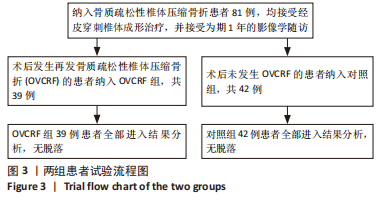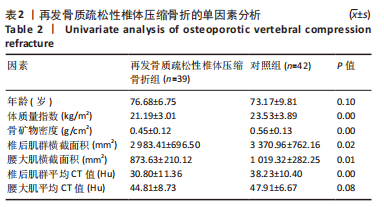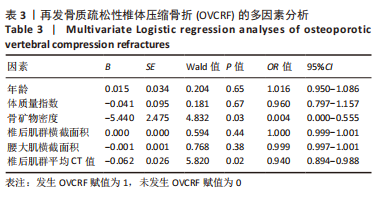[1] IOLASCON G, DE SIRE A, CURCI C, et al. Osteoporosis guidelines from a rehabilitation perspective: systematic analysis and quality appraisal using AGREE II. Eur J Phys Rehabil Med. 2021;57(2):273-279.
[2] 邱敏丽,谢雅,王晓红,等.骨质疏松症患者实践指南[J].中华内科杂志,2020,59(12):953-959.
[3] 朱洁云,高敏,宋秋韵,等.中国老年人骨质疏松症患病率的Meta分析[J].中国全科医学,2022,25(3):346-353.
[4] SI L, WINZENBERG TM, JIANG Q, et al. Projection of osteoporosis-related fractures and costs in China: 2010-2050. Osteoporosis Int. 2015, 26(7):1929-1937.
[5] 董明,杨华清,李强,等.经皮椎体后凸成形术治疗胸腰段椎体骨折伴腰骶臀区疼痛[J].中国矫形外科杂志,2020,28(8):755-757.
[6] 冯子田,董乐乐,王丰,等.经皮椎体后凸成形术治疗老年性骨质疏松性椎体压缩性骨折的近期疗效观察[J].包头医学院学报,2022, 38(12):48-51.
[7] 杨楠,王胜宝,刘双福,等.机器人辅助经皮穿刺椎体成形术治疗老年骨质疏松性椎体压缩骨折的疗效分析[J].华西医学,2022, 37(10):1471-1475.
[8] BALASUBRAMANIAN A, ZHANG J, CHEN L, et al. Risk of subsequent fracture after prior fracture among older women. Osteoporos Int. 2019;30:79-92.
[9] 雷小平, 李勇, 晁建虎, 等. 腰椎稳定性与腰背肌退变的相关性分析[J]. 中国综合临床,2015,31(11):1029-1031.
[10] HUANG W, CAI XH, LI YR, et al. The association between paraspinal muscle degeneration and osteoporotic vertebral compression fracture severity in postmenopausal women. J Back Musculoskelet Rehabil. 2022. doi: 10.3233/BMR-220059.
[11] ERLANDSON MC, LORBERGS AL, MATHUR S, et al. Muscle analysis using pQCT, DXA and MRI. Eur J Radiol. 2016;85(8):1505-1511.
[12] SINELNIKOV A, QU C, FETZER DT, et al. Measurement of skeletal muscle area: comparison of CT and MR imaging. Eur J Radiol. 2016;85(10): 1716-1721.
[13] GALLAGHER D, VISSER M, DE MEERSMAN RE, et al. Appendicular skeletal muscle mass: effects of age, gender, and ethnicity. J Appl Physiol. 1997;83(1):229-239.
[14] WONG AKO, BEATTIE KA, MIN KKH, et al. Peripheral quantitative computed tomography-derived muscle density and peripheral magnetic resonance imaging-derived muscle adiposity: precision and associations with fragility fractures in women. J Musculoskelet Neuronal Interact. 2014;14(4):401-410.
[15] NAMM JP, THAKRAR KH, WANG CE, et al. A Semi-Automated Assessment of Radiographic Sarcopenia Using Psoas Area and Density Predicts Outcomes after Pancreaticoduodenectomy for Malignancy. J Am Coll Surg. 2016;223(4):e24.
[16] KALICHMAN L, HODGES P, LI L, et al. Changes in paraspinal muscles and their association with low back pain and spinal degeneration: CT study. Eur Spine J. 2010;19:1136-1144.
[17] 中华医学会骨科学分会.骨质疏松性骨折诊疗指南(2022年版)[J].中华骨科杂志,2022,42(22):1473-1491.
[18] 蒋燕飞.女性绝经后发生骨质疏松症的危险因素及其预防措施分析[J].中国妇幼保健,2021,36(12):2857-2859.
[19] STREICHER C, HEYNY A, ANDRUKHOVA O, et al. Estrogen regulates bone turnover by targeting RANKL expression in bone lining cells. Sci Rep. 2017;7(1):1-14.
[20] ZHA L, HE L, LIANG Y, et al. TNF-α contributes to postmenopausal osteoporosis by synergistically promoting RANKL-induced osteoclast formation. Biomed Pharmacother. 2018;102:369-374.
[21] WANG WF, LIN CW, XIE CN, et al. The association between sarcopenia and osteoporotic vertebral compression refractures. Osteoporos Int. 2019;30:2459-2467.
[22] 杨乐,张宝,管石侠,等.体质指数对类风湿关节炎患者发生肌少症的影响[J].安徽医科大学学报,2020,55(2):296-300.
[23] 缪克团,许兵,王萧枫,等.绝经后女性肌少症与骨质疏松症的相关性研究[J].中国医药导报,2020,17(32):104-107+111.
[24] GOMARASCA M, BANFI G, LOMBARDI G. Myokines: The endocrine coupling of skeletal muscle and bone. Adv Clin Chem. 2020;94: 155-218.
[25] HE C, HE W, HOU J, et al. Bone and muscle crosstalk in aging. Frontiers in Cell and Dev Biol. 2020;8:585644.
[26] AL-GINDAN YY, HANKEY CR, LESLIE W, et al. Predicting muscle mass from anthropometry using magnetic resonance imaging as reference: a systematic review. Nutr Rev. 2014;72(2):113-126.
[27] WAGNER H, ANDERS CH, PUTA CH, et al. Musculoskeletal support of lumbar spine stability. Pathophysiology. 2005;12(4):257-265.
[28] 李沐风,朱宇航,刘宇龙,等.腰大肌的解剖学及其与腰大肌综合征的相关研究进展[J].中国实验诊断学,2021,25(3):466-468.
[29] 徐森明,覃兴乐.多裂肌退变与脊柱疾病的关系研究进展[J].中国康复医学杂志,2022,37(5):709-713.
[30] 赵云芳,滕范文,香淑媚.PVP术后对邻近节段椎体生物力学影响的有限元分析[J].齐齐哈尔医学院学报,2015,36(20):2980-2981.
[31] CHEN Q, LEI C, ZHAO T, et al. Relationship between sarcopenia/paravertebral muscles and the incidence of vertebral refractures following percutaneous kyphoplasty: a retrospective study. BMC Musculoskelet Disord. 2022;23(1):1-8.
[32] HABIBI H, TAKAHASHI S, HOSHINO M, et al. Impact of paravertebral muscle in thoracolumbar and lower lumbar regions on outcomes following osteoporotic vertebral fracture: a multicenter cohort study. Arch Osteoporos. 2021;16:1-7.
[33] 王伟,李危石,陈仲强.椎旁肌评价方法及其与腰椎疾病相关性的研究进展[J].中国修复重建外科杂志,2020,34(11):1462-1467.
[34] XIONG A. P44. Computed tomography Hounsfield units accurately estimate the severity of cervical paraspinal muscle fat infiltration. Spine J. 2020;20(9):S167.
[35] GOODPASTER BH, KELLEY DE, THAETE FL, et al. Skeletal muscle attenuation determined by computed tomography is associated with skeletal muscle lipid content. J Appl Physiol. 2000;89(1):104-110.
[36] ENGELKE K, MUSEYKO O, WANG L, et al. Quantitative analysis of skeletal muscle by computed tomography imaging—State of the art.J Orthop Trans. 2018;15:91-103.
[37] 张树宝,王善金,徐浩伟,等.躯干肌功能与骨质疏松性椎体骨折的相关性研究进展[J].脊柱外科杂志,2021,19(2):126-129+144.
[38] HICKS GE, SIMONSICK EM, HARRIS TB, et al. Cross-sectional associations between trunk muscle composition, back pain, and physical function in the health, aging and body composition study. J Gerontol A Biol Sci Med Sci. 2005;60(7):882-887.
[39] 高辉,张堃,黎芳丽,等.Revolution CT物质分离技术探索腰椎椎旁肌内肌与脂含量随年龄的变化规律[J].临床放射学杂志,2020, 39(6):1153-1157.
[40] FROST HM. Bone’s mechanostat: a 2003 update. The Anatomical record part A, discoveries in molecular, cellular, and evolutionary biology. 2003;275(2):1081-1101.
[41] ABDALA R, LEVI L, LONGOBARDI V, et al. Severe bone microarchitecture deterioration in a family with hereditary neuropathy: evidence of the key role of the mechanostat. Osteoporos Int. 2020;31:2477-2480.
[42] WANG L, YOU X, LOTINUN S, et al. Mechanical sensing protein PIEZO1 regulates bone homeostasis via osteoblast-osteoclast crosstalk. Nat Commun. 2020;11(1):282.
|





